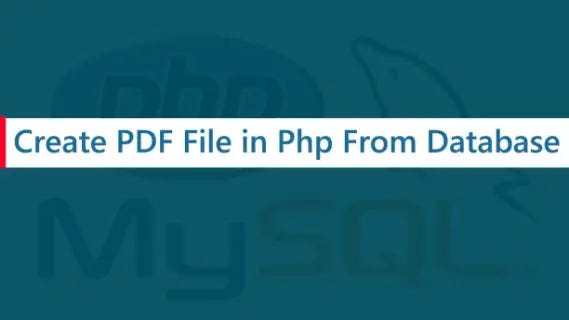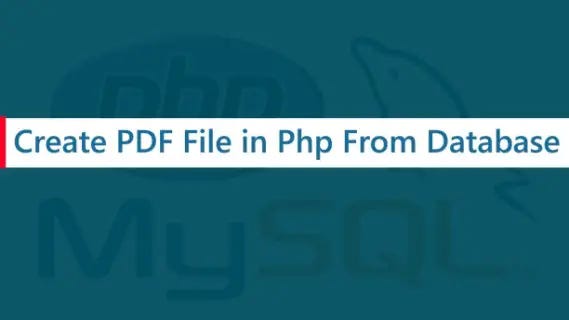Php Generate PDF From HTML
 OnlineITtuts
OnlineITtuts
In this article, we will be discussing how to generate PDF files from HTML using the PHP programming language. We will go through each step necessary to create these PDF files, including setting up the environment, code structure, and more.
Php Generate PDF From HTML Creating can be a very daunting task.

There are many challenges that must be overcome, such as ensuring that the PDF file looks identical to the HTML file, setting up the environment, code structure, and more.
However, with the right tools and a little bit of knowledge, it is possible to create PDF files from HTML using PHP. In this article, we will go through each step necessary to create these PDF files.
What is a PDF?
A PDF is a Portable Document Format, and it is a file format that is used to present documents in a manner that is independent of application software, hardware, and operating systems. PDFs are created in order to keep the formatting of a document consistent across different devices and platforms.
How to Generate a PDF From HTML in PHP?
If you need to generate a PDF from HTML, there are a few options available to you. One popular option is to use the TCPDF library. This library is free and open source, and it offers a wide range of features.
Another option is to use the FPDF library. This library is also free and open source, and it offers similar functionality to TCPDF.
Once you have decided which solution to use, you can follow the instructions below to generate a PDF from HTML in PHP.
Use the appropriate library or tool for your needs.
Convert the HTML document into a PDF document using the library or tool that you have chosen.
Save the PDF document to a file or stream it to the browser for output.
Why Would You Want to Php Generate PDF From HTML?
There are a number of reasons you might want to generate a PDF from HTML. Maybe you need to generate a report or share some data with someone who doesn’t have access to the same software as you.
Maybe you want to create a printable version of a web page. Whatever the reason, there are a few different ways to go about generating a PDF from HTML.
One way is to use a library like TCPDF or FPDF. These libraries allow you to generate PDFs from HTML code. They’re free and easy to use, and they can be a good option if you need to generate simple PDFs.
Finally, you can always just save the HTML as a PDF. This will work in most cases, but it’s not always the best option since the formatting can get messed up.
Which option you choose will depend on your needs. If you just need to generate a simple PDF, then using a library like TCPDF or FPDF is probably your best.
How to Generate PDF in Php Dynamically
In this blog section, we will provide an example of how to generate PDFs from HTML using PHP. We will also discuss some of the benefits of using this method to generate PDFs.
First of All, you need to make a connection in Php, I’ve made the connection with the name of the connection.php and also I’ve mentioned the simple code on below.
$con = mysqli_connect('localhost','root','','cms');
if(!$con)
{
die('Connection Error');
}
?>
Then the next thing you need to create an index.php inside the page you need to get the data from the database and display it on your HTML page.
I’ve used Bootstrap to design the HTML and table, if you like it, you need to add the Bootstrap CSS file inside the document, then you will able to see tbe he same result on your page.
<?php
require_once 'connection.php';
$sql = " select * from posts";
$data = mysqli_query($con,$sql);
?>
<!doctype html>
<html lang="en">
<head>
<meta charset="UTF-8">
<meta name="viewport"
content="width=device-width, user-scalable=no, initial-scale=1.0, maximum-scale=1.0, minimum-scale=1.0">
<meta http-equiv="X-UA-Compatible" content="ie=edge">
<link rel="stylesheet" href="CSS/bootstrap.css">
<title>Create a PDF File in Php</title>
</head>
<body style="background: #CCCCCC">
<div class="row">
<div class="col">
<div class="container">
<div class="card mt-5">
<div class="card-header">
<form action="pdf_gen.php" method="POST">
<button type="submit" name="btn_pdf" class="btn btn-success">PDF</button>
</form>
</div>
<div class="card-body">
<table class="table table-striped">
<tr>
<th> Post ID </th>
<th> Post Title </th>
<th> Post Author </th>
<th> Post Date </th>
<th> Post Status </th>
</tr>
<?php
while($row = mysqli_fetch_assoc($data))
{
?>
<tr>
<td><?php echo $row['post_id']; ?></td>
<td><?php echo $row['post_title']; ?></td>
<td><?php echo $row['post_author']; ?></td>
<td><?php echo $row['post_date']; ?></td>
<td><?php echo $row['post_status']; ?></td>
</tr>
<?php
}
?>
</table>
</div>
</div>
</div>
</div>
</div>
</body>
</html>
once you do that, you will able to see the database values that have been appeared on the HTML page. Then the next thing you need to get the FPDF library from the FPDF.Org official page, then you need to add it to your project.
Once you add it, then you need to call it with another page, I’ve mentioned pdf_gen.php inside the Button area.
It means the user clicks on the Button, which will redirect with pdf_gen.php, inside the page we need to configure the FPDF library to Generate the PDF File.
So, I’ve mentioned the complete code for this process, you need to read it and then you need to follow the code. Once you follow up on it, then I hope you will be able to do that.
<?php
require_once 'FPDF/fpdf.php';
require_once 'connection.php';
$sql = " select * from posts";
$data = mysqli_query($con,$sql);
if(isset($_POST['btn_pdf']))
{
$pdf = new FPDF('p','mm','a4');
$pdf->SetFont('arial','b','14');
$pdf->AddPage();
$pdf->cell('25','10','Post ID','1','0','C');
$pdf->cell('45','10','Post Title','1','0','C');
$pdf->cell('45','10','Post Author','1','0','C');
$pdf->cell('30','10','Post Date','1','0','C');
$pdf->cell('30','10','Post Status','1','1','C');
$pdf->SetFont('arial','','12');
while($row = mysqli_fetch_assoc($data))
{
$pdf->cell('25','10', $row['post_id'],'1','0','C');
$pdf->cell('45','10', $row['post_title'],'1','0','C');
$pdf->cell('45','10', $row['post_author'],'1','0','C');
$pdf->cell('30','10', $row['post_date'],'1','0','C');
$pdf->cell('30','10', $row['post_status'],'1','1','C');
}
$pdf->Output();
}
That’s it for Php Generate PDF From HTML step by step with source code. I hope you understand as well all about it. If you face any problems with the code, you can watch the video tutorial.
How to Generate PDF in PHP dynamically using FPDF
Guys, PHP Generate PDF From HTML I’ve used the FPDF library, it’s very simple to use on your PHP document. You need to it on your document and set it How many columns do you want to add to your PDF File and also some extra details do you want to add? So, You can watch the video tutorial that helps you understand everything step by step practically.
Conclusion
There are a number of reasons why you might want to generate a PDF from HTML. Maybe you have a web page that you want to share with someone but you don’t want them to be able to edit the content.
You May Also Like:
Or maybe you need to create a printable version of your web page for an event or trade show. Whatever the reason, there are several PHP libraries that can help you generate PDFs from HTML quickly and easily.
We’ve also given you a few tips on how to get started with each library. So if you need to generate PDFs from HTML, now you know where to start. So, I hope this tutorial is helpful and beneficial for you. Please share it on social sharing websites with personal friends.
Subscribe to my newsletter
Read articles from OnlineITtuts directly inside your inbox. Subscribe to the newsletter, and don't miss out.
Written by

OnlineITtuts
OnlineITtuts
As a dedicated front-end developer, I am passionate about crafting immersive and user-friendly digital experiences. With a keen eye for design and proficiency in HTML, CSS, and JavaScript, I specialize in translating creative concepts into responsive and visually appealing websites. My commitment to staying abreast of industry trends and technologies allows me to create dynamic and engaging user interfaces. Whether optimizing for mobile responsiveness or ensuring cross-browser compatibility, I bring a meticulous approach to every project. With a strong foundation in front-end frameworks like React and Angular, I thrive on transforming ideas into seamless, interactive, and aesthetically pleasing web applications that leave a lasting impression on users."